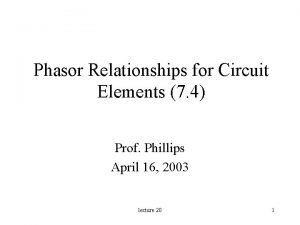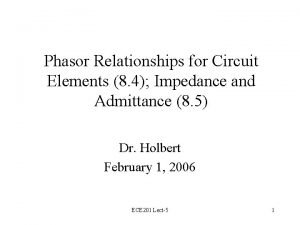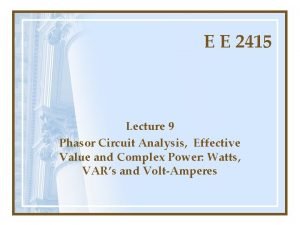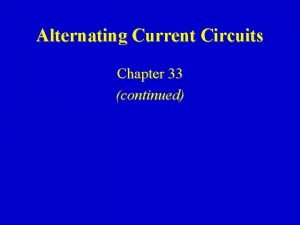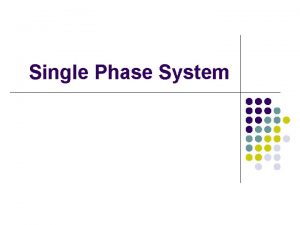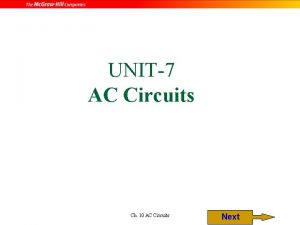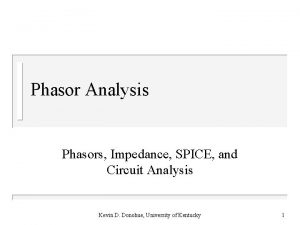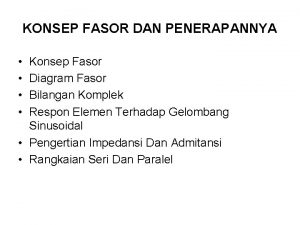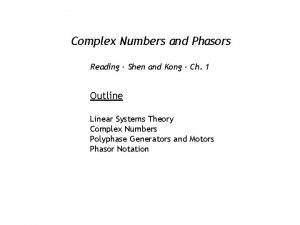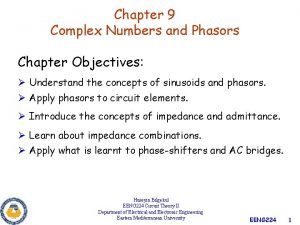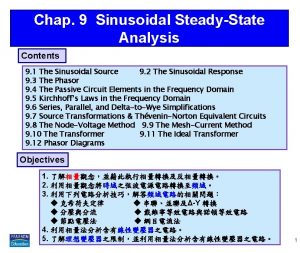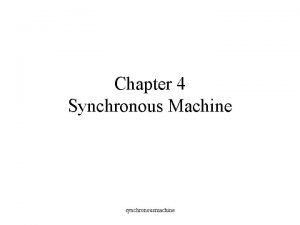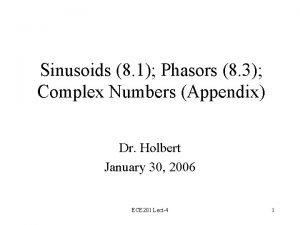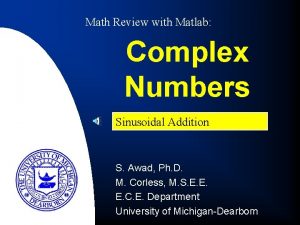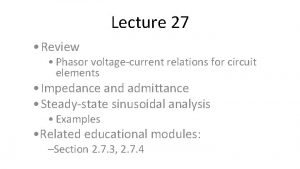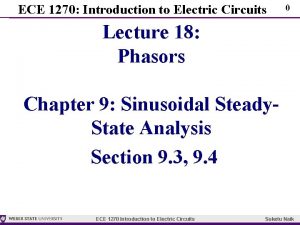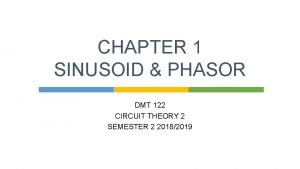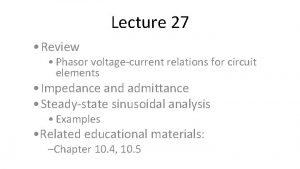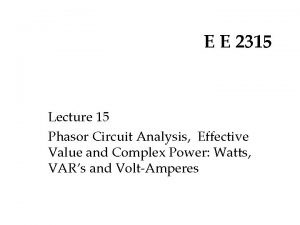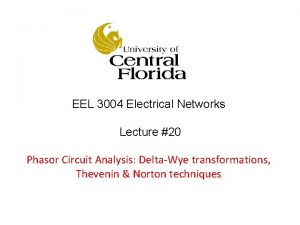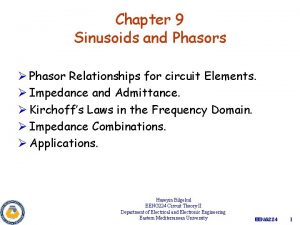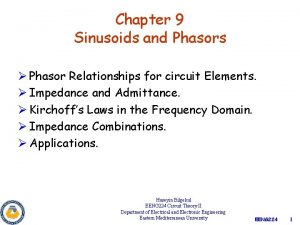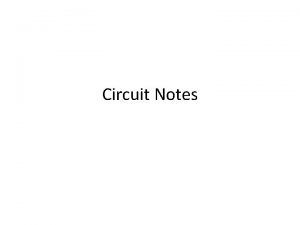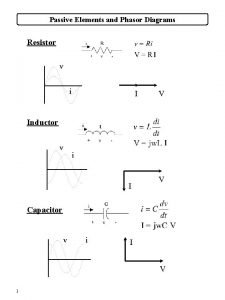Phasor Relationships for Circuit Elements 7 4 Prof





















- Slides: 21

Phasor Relationships for Circuit Elements (7. 4) Prof. Phillips April 16, 2003 lecture 20 1

Phasor Relationships for Circuit Elements • Phasors allow us to express current-voltage relationships for inductors and capacitors much like we express the current-voltage relationship for a resistor. • A complex exponential is the mathematical tool needed to obtain this relationship. lecture 20 2

I-V Relationship for a Resistor + i(t) v(t) R – Suppose that i(t) is a sinusoid: i(t) = IM ej(wt+q) Find v(t) lecture 20 3

Computing the Voltage lecture 20 4

Class Example lecture 20 5

I-V Relationship for a Capacitor + i(t) v(t) C – Suppose that v(t) is a sinusoid: v(t) = VM ej(wt+q) Find i(t) lecture 20 6

Computing the Current lecture 20 7

Phasor Relationship • Represent v(t) and i(t) as phasors: V = VM q I = jw. C V • The derivative in the relationship between v(t) and i(t) becomes a multiplication by jw in the relationship between V and I. lecture 20 8

Example v(t) = 120 V cos(377 t + 30 ) C = 2 m. F • What is V? • What is I? • What is i(t)? lecture 20 9

Class Example lecture 20 10

I-V Relationship for an Inductor + i(t) v(t) L – V = jw. L I lecture 20 11

Example i(t) = 1 m. A cos(2 p 9. 15 • 107 t + 30 ) L = 1 m. H • What is I? • What is V? • What is v(t)? lecture 20 12

Class Example lecture 20 13

Circuit Element Phasor Relations (ELI and ICE man) lecture 20 14

Phasor Diagrams • A phasor diagram is just a graph of several phasors on the complex plane (using real and imaginary axes). • A phasor diagram helps to visualize the relationships between currents and voltages. lecture 20 15

An Example 2 m. A 40 + + 1 m. F w = 377 1 k. W – VC + – V VR – lecture 20 16

An Example (cont. ) I = 2 m. A 40 VR = 2 V 40 VC = 5. 31 V -50 V = 5. 67 V -29. 37 lecture 20 17

Phasor Diagram Imaginary Axis Real Axis V VC VR lecture 20 18

MATLAB Exercise • Let’s use MATLAB to plot an ac current and voltage, and then to graphically determine the lead-lag relationship • Start MATLAB on your computer • We begin by creating a time vector >> t = 0 : 0. 0005 : 0. 025; • Next, we create the voltage and current >> vt = 170 * cos(377*t+10*pi/180); >> it = 100 * cos(377*t-65*pi/180); lecture 20 19

MATLAB Exercise • Now we will graph v(t) and i(t) >> plot(t, vt, 'b', t, it, 'r--'); >> xlabel('Time (sec)'); >> ylabel('Voltage (Volts) or Current (Amps)'); >> title('Household AC Voltage-Current'); >> legend('v(t)=170 cos(377 t+10)', 'i(t)=100 cos(377 t-65)'); lecture 20 20

MATLAB Exercise • From the graphs created: – Determine whether the current leads the voltage, or vice versa – Determine the amount of lead by the current or voltage • Compare the voltage-current lead-lag relationship obtained by graphical means above to an analytic solution which you should be able to compute lecture 20 21
 Eli the ice man
Eli the ice man Phasor relationships for circuit elements
Phasor relationships for circuit elements Phasor circuit analysis example
Phasor circuit analysis example Phasor diagram of rl circuit
Phasor diagram of rl circuit Voltage triangle for rc series circuit
Voltage triangle for rc series circuit Power factor of pure resistive circuit is
Power factor of pure resistive circuit is Phasor diagram of lcr circuit
Phasor diagram of lcr circuit Phasor diagram
Phasor diagram Phasor notation
Phasor notation Apakah yang dimaksud dengan fasor dan diagram fasor
Apakah yang dimaksud dengan fasor dan diagram fasor Adding polar form
Adding polar form Exponential form to cartesian form
Exponential form to cartesian form Sinusoidal expression
Sinusoidal expression Phasor diagram of synchronous motor
Phasor diagram of synchronous motor Instantaneous magnitude
Instantaneous magnitude Complex number magnitude
Complex number magnitude Complex sinusoid matlab
Complex sinusoid matlab Phasor adder
Phasor adder Phasor domain analysis
Phasor domain analysis Phasors
Phasors Voltage in parallel circuit
Voltage in parallel circuit Different types of circuits
Different types of circuits
